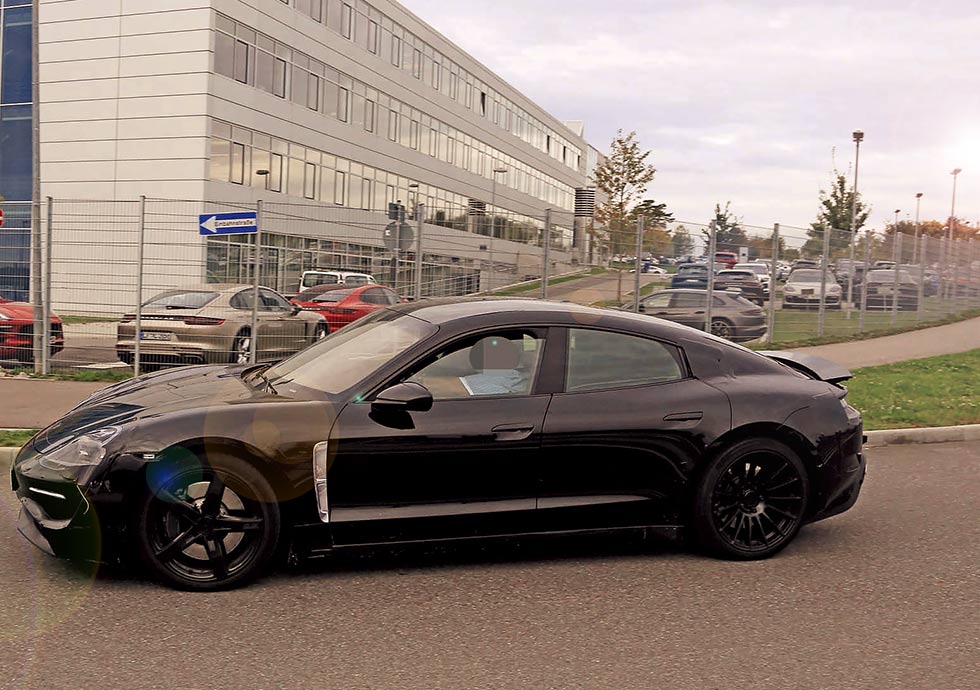Porsche’s Project Mission E takes shape. Production version of Porsche’s first pure-electric car breaks cover.
Production bodied Mission E caught testing at Weissach.
Porsche’s Mission E electric car has been spotted testing with its final production body for the first time. Due to go on sale in 2019, Mission E will not only be the first pureelectric Porsche, it will also debut radical new autonomous driving technology.

Snapped outside Porsche’s Weissach R&D centre, Porsche has used multiple camouflage elements in an effort to obscure its identity. But this is no Panamera-based mule. Close inspection reveals that this is, indeed, the production Mission E body.
Look carefully and you can see the Mission E’s distinctive nose complete with four-point headlights and wide openings up front. Along the cars flanks Porsche has used the same new-generation flush-fit door handles also seen in the upcoming Type-992 911 development cars. The rake of the roofline is also distinct from any Panamera, as are the broad rear hips.
Another tell-tale sign involves the glass house. The trim strip running across the top of the side windows is unbroken, indicating that the Mission E’s frameless door glass will be making it into production, though not its ‘suicide’ rear doors. The Mission E concept’s extreme, low-set proportions have likewise been toned down in the transition to production. That’s perhaps inevitable given that the car will need to offer excellent cabin space to appeal to the mass market.
Mission E will be based on an all-new platform known as J1, developed for broad use across the Volkswagen group and designed expressly for pure-electric power. Final technical details of the Mission E are not known. However, Porsche has indicated certain targets. Overall operating range will be in excess of 330 miles and power will come from a pair of electric motors good for a total system power in the region of 600hp. Mission E will be quick, very quick.
Another key element involves Mission E’s revolutionary charging technology. Porsche is developing a new system with Japanese electronics specialist Hitachi.
Based around 800V technology, it’s said to offer double the energy throughput of Tesla’s latest 400V Supercharger tech. Porsche Chairman Oliver Blume has gone on the record stating the new charging tech will allow Mission E to recharge to 80 per cent battery capacity in just 15 mins despite the high capacity of its lithium-ion cells.
The final part of the Mission E package will arguably be even more controversial for a Porsche than electric power. Mission E will arrive with what’s known as Level 4 selfdriving technology. That’s a nod to the fivelevel regime for autonomous cars recently defined by the US Department of Transportation. Level 1 involves individual elements, like braking or accelerating, being intermittently controlled by the car, for instance cruise control.
Level 2 requires at least two control elements autonomously controlled at least partially in response to external data regarding the driving environment. Level 3 still requires a human driver but ups the ante to offloading many safety-critical driving functions to the car along with full control in certain narrowly defined scenarios, such as motorway cruising. Level 4, which is the target for Mission E, enables fully autonomous driving in many but not all scenarios and road conditions. Level 5 refers to cars that can operate fully autonomously in all scenarios and have no requirement for a human driver.
Given that Porsche typically trades on offering the most exciting and engaging driving dynamics in each segment in which it competes, including with its SUV Macan and Cayenne models, promoting autonomous driving capabilities may seem like an odd fit. However, competing with the likes of Tesla’s Model S almost certainly demands that Porsche offers advanced self-driving technology. It’s a feature Tesla is already pushing hard. The final production version of Mission E will likely be revealed in 2019 and go on sale in 2020 at around £90,000.
Not quite as low as the Mission E concept, nevertheless it’s fair to say that this is the production bodyshell in disguise, judging by the distinctive nose. Those dummy exhaust pipes don’t fool us! Range should be in excess of 330 miles. Launch will be in 2019, with sales commencing in 2020.





